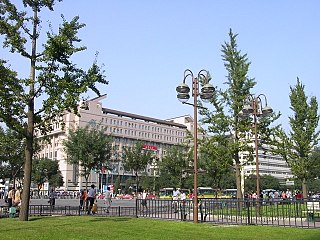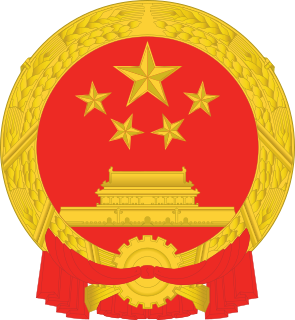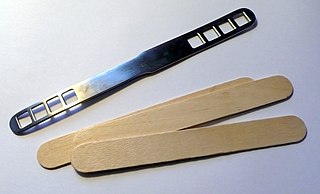This article needs to be updated.(September 2013) |
| Formation | 1950 (predecessor organization) 2013 (latest re-organization) |
|---|---|
| Type | Ministry-level regulatory body |
| Headquarters | 26-Yuan, Xuanwumen Avenue West, Xicheng District, Beijing |
| Location |
|
Director | Bi Jingquan |
Deputy Directors | Yin Li, Wang Mingzhu, Teng Jiacai, Wu Zhen, Jiao Hong |
Discipline Inspection Leader | Li Wusi |
Parent organization | State Council of the People's Republic of China |
| Affiliations | Commission on Food Safety |
| Website | eng |

The China Food and Drug Administration (CFDA) [1] (Chinese :国家食品药品监督管理总局) was founded on the basis of the former State Food and Drug Administration (SFDA). In March 2013, the regulatory body was rebranded and restructured as the China Food and Drug Administration, elevating it to a ministerial-level agency. [2] The headquarters are in Xicheng District, Beijing. [3]

Simplified Chinese characters are standardized Chinese characters prescribed in the Table of General Standard Chinese Characters for use in mainland China. Along with traditional Chinese characters, they are one of the two standard character sets of the contemporary Chinese written language. The government of the People's Republic of China in mainland China has promoted them for use in printing since the 1950s and 1960s to encourage literacy. They are officially used in the People's Republic of China and Singapore.

Xicheng District is a district of Beijing. Xicheng District spans 32 square kilometres (12 sq mi), making it the largest portion of the old city, and has 706,691 inhabitants. Its postal code is 100032. Xicheng is subdivided into 15 subdistricts of the city proper of Beijing. The former Xuanwu District was merged into Xicheng on July 2010.

Beijing, formerly romanized as Peking, is the capital of the People's Republic of China, the world's third most populous city proper, and most populous capital city. The city, located in northern China, is governed as a municipality under the direct administration of central government with 16 urban, suburban, and rural districts. Beijing Municipality is surrounded by Hebei Province with the exception of neighboring Tianjin Municipality to the southeast; together the three divisions form the Jingjinji metropolitan region and the national capital region of China.
Contents
- Main responsibilities
- Registration for medical devices
- Organizational structure
- Principal officials
- Standards and regulations
- Performance
- See also
- References
- Further reading
- External links
The CFDA replaced a large group of overlapping regulators with an entity similar to the Food and Drug Administration of the United States, streamlining regulation processes for food and drug safety. [4] The China Food and Drug Administration is directly under the State Council of the People's Republic of China, which is in charge of comprehensive supervision on the safety management of food, health food and cosmetics and is the competent authority of drug regulation in mainland China. [5]

The Food and Drug Administration is a federal agency of the United States Department of Health and Human Services, one of the United States federal executive departments. The FDA is responsible for protecting and promoting public health through the control and supervision of food safety, tobacco products, dietary supplements, prescription and over-the-counter pharmaceutical drugs (medications), vaccines, biopharmaceuticals, blood transfusions, medical devices, electromagnetic radiation emitting devices (ERED), cosmetics, animal foods & feed and veterinary products. As of 2017, 3/4th of the FDA budget is paid by people who consume pharmaceutical products, due to the Prescription Drug User Fee Act.

The State Council, constitutionally synonymous with the Central People's Government since 1954, is the chief administrative authority of the People's Republic of China. It is chaired by the premier and includes the heads of each of the cabinet-level executive departments. Currently, the council has 35 members: the premier, one executive vice premier, three other vice premiers, five state councilors, and 25 additional ministers and chairs of major agencies. In the politics of the People's Republic of China, the Central People's Government forms one of three interlocking branches of power, the others being the Communist Party of China and the People's Liberation Army. The State Council directly oversees the various subordinate People's Governments in the provinces, and in practice maintains membership with the top levels of the Communist Party of China.

Mainland China, also known as the Chinese mainland, is the geopolitical as well as geographical area under the direct jurisdiction of the People's Republic of China (PRC). It includes Hainan island and strictly speaking, politically, does not include the special administrative regions of Hong Kong and Macau, even though both are partially on the geographic mainland.
On July 10, 2007, Zheng Xiaoyu, the former head of China's State Food And Drug Administration, was executed for taking bribes from various firms in exchange for state licenses related to product safety. [6]

Zheng Xiaoyu was the director of the State Food and Drug Administration of the People's Republic of China from 2003 to 2005. He was sentenced to death for corruption and allowing possibly tainted products in Mainland China in the first instance trial at Beijing No.1 Intermediate Court on May 29, 2007. He was executed on July 10, 2007.
As part of China's 2018 government administration overhaul, the CFDA was merged into the newly-created State Administration for Market Regulation.

The State Administration for Market Regulation (SAMR) is the People's Republic of China's governmental authority for regulating areas such as market competition, monopolies, intellectual property, and drug safety. The Administration was created in the 2018 Chinese overhaul of government administration, and merged or abolished a number of previous agencies, such as the State Intellectual Property Office.






